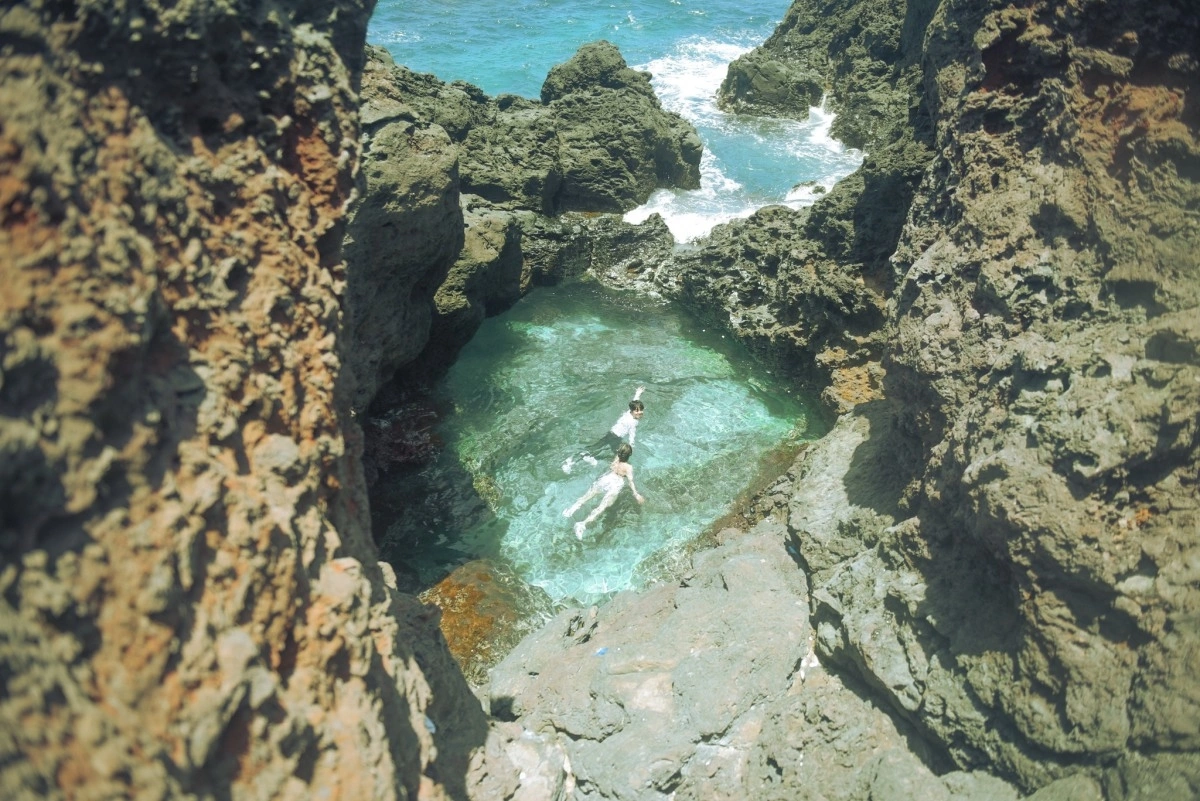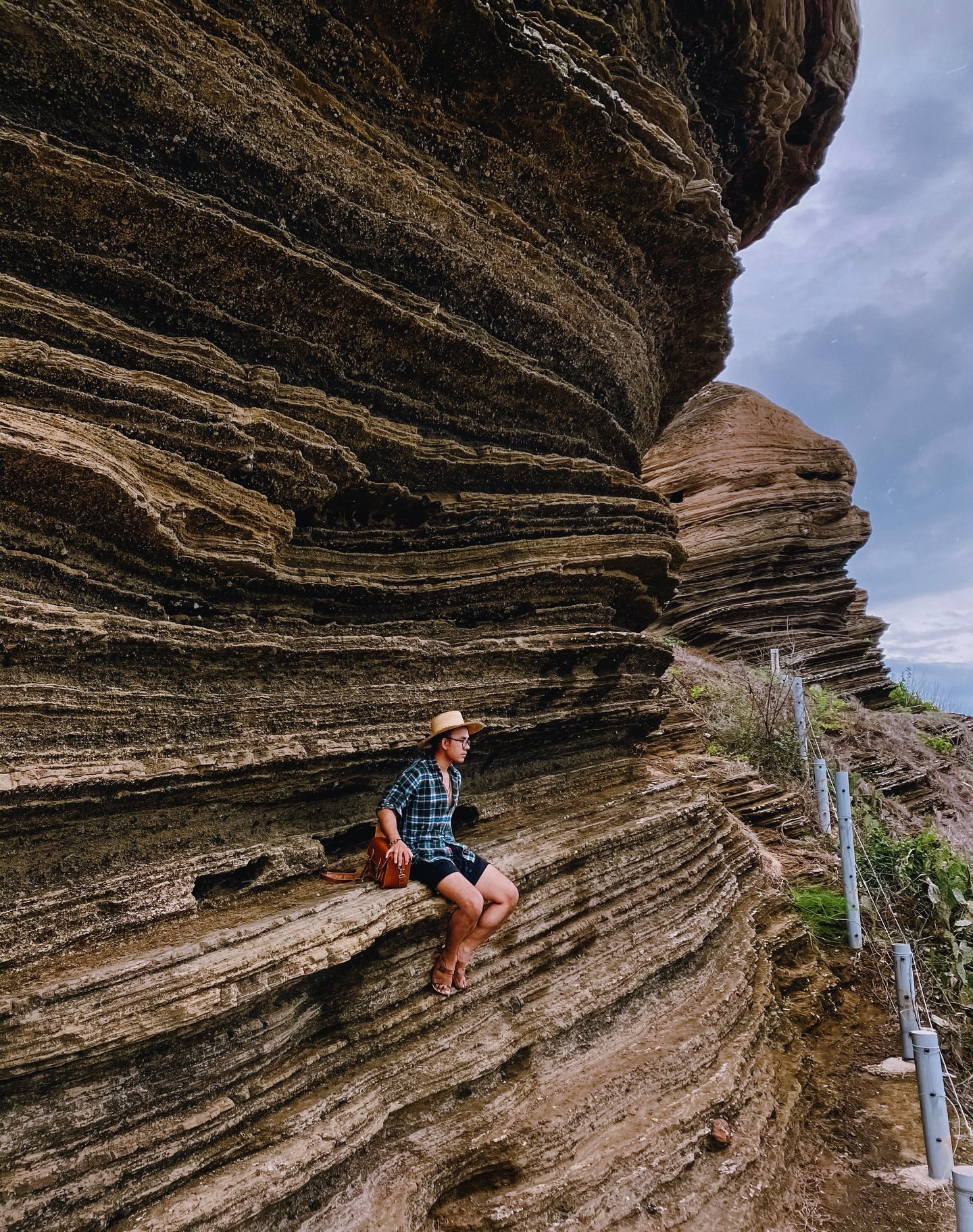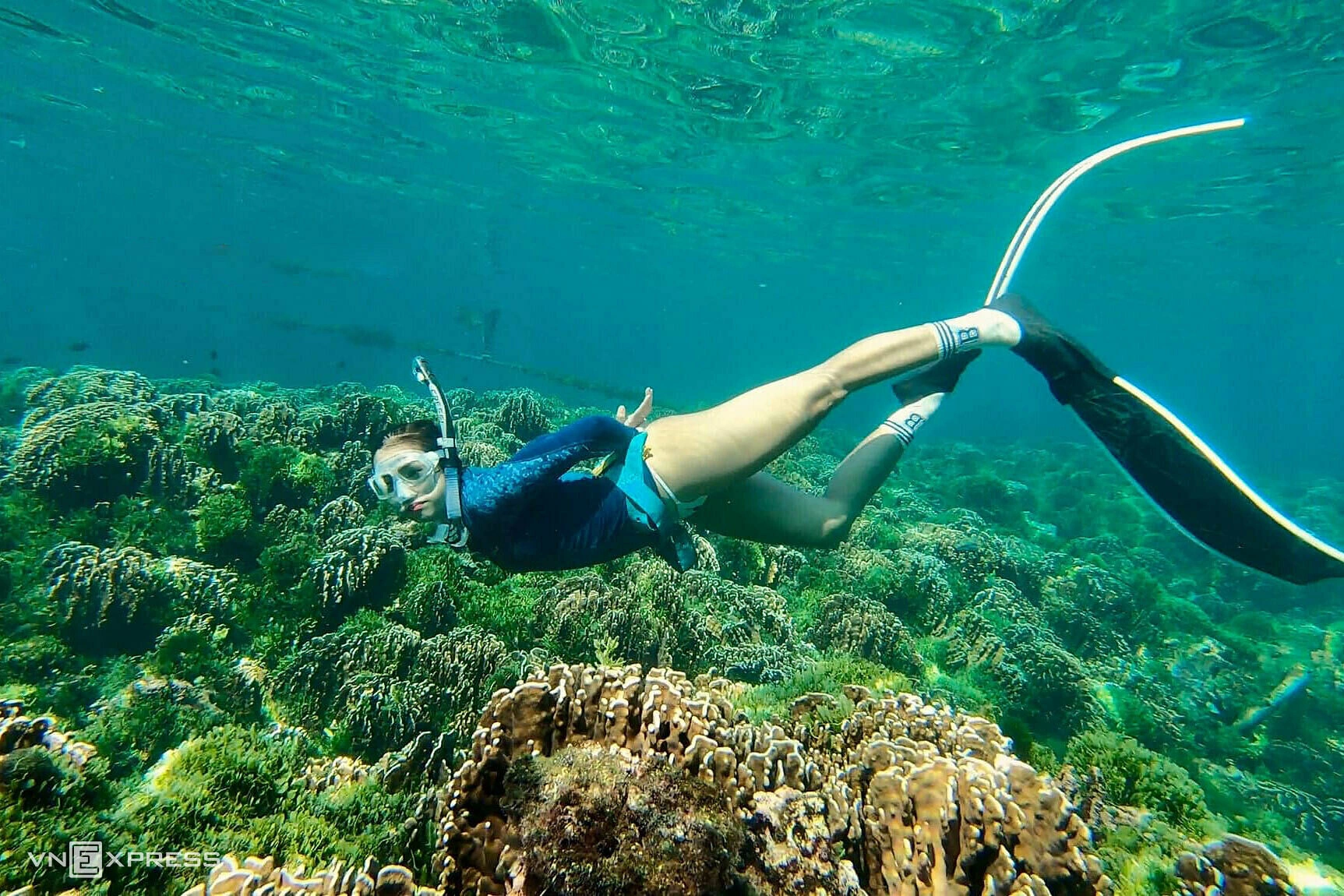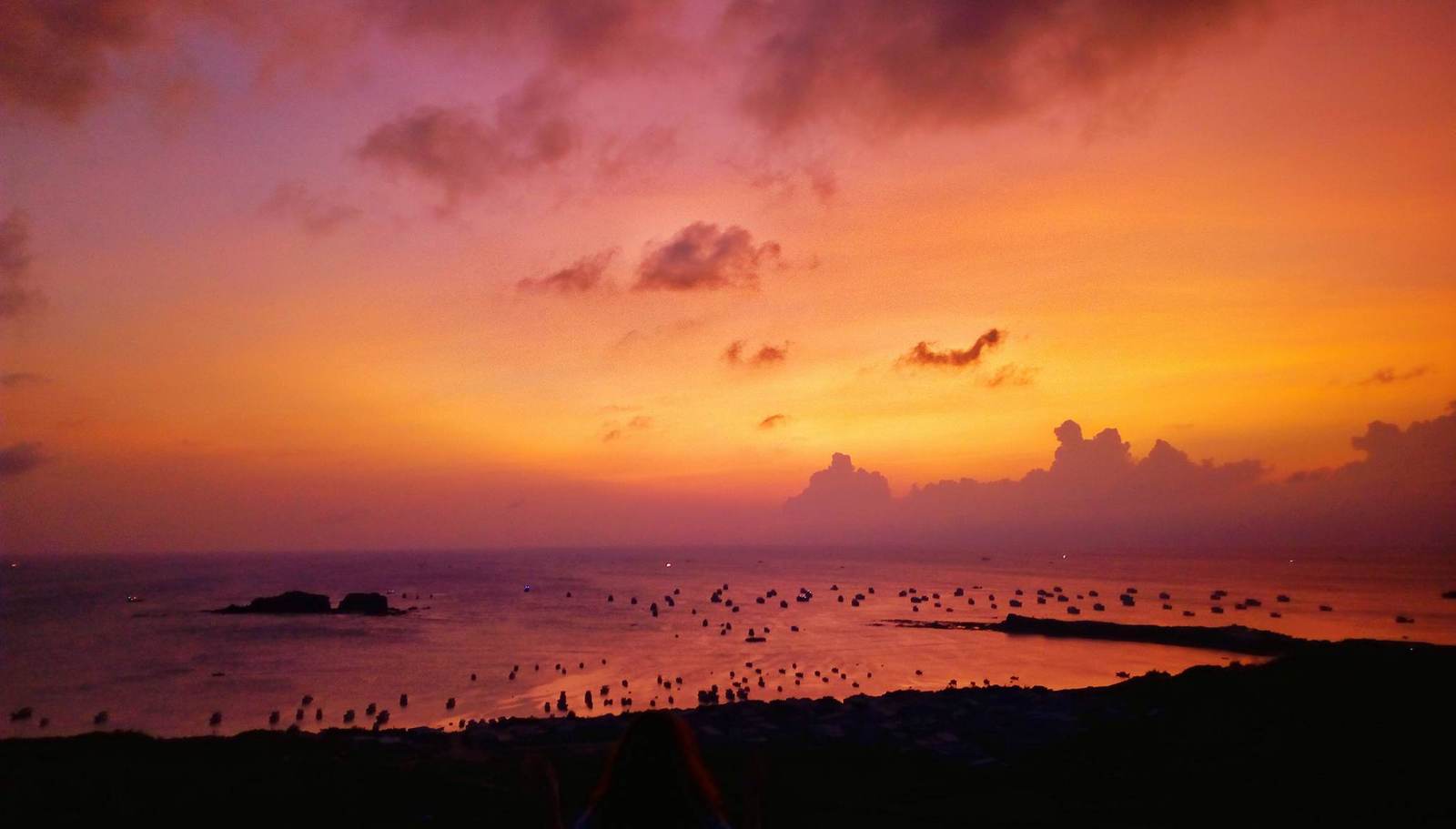
Phu Quy is a small island that is big on beautiful scenery and landscapes. Blessed with beautiful beaches, coral reefs and other wonders of nature, this little slice of paradise of just 18 square kilometers is also home to many historical and cultural sites that showcase the heart of Vietnam.
Phu Quy, also known as Thu Island or Khoai Xu Island, is about 120 kilometers southeast of the central coast city of Phan Thiet in Binh Thuan province. The island’s climate is cool all year round.

The best time to explore Phu Quy is from December to June, as the storm season usually falls from September to November. During the spring and summer seasons, the sea is calm and winds are light, so visitors can easily travel to the small island. However, travelers are always advised to check the weather forecast in advance in case of rough seas.
Trieu Duong Bay
Trieu Duong Bay can be found off the major road that circles the island. This is a small beach with clear blue water kissing a long wide stretch of soft white sand. Locals come here in the afternoons to swim.

Bai Nho Beach
Bai Nho Beach is a crescent-shaped beach, charmed by its mountain backdrop. Visitors just need to park their motorbikes on the road and follow a trail down the hill to the beach. Some of Phu Quy’s other attractive beaches include Doi Dua in Ngu Phung Commune and the beach near the district committee park.
Ganh Hang Cliff
About 650 meters from Bai Nho Beach, Ganh Hang is a large cliff above the sea. As waves crashing against the rocks have created "Khe Sung Suong" - a sea inlet, which also contains a natural "infinity pool" popular with tourists.
Visitors should bring a sturdy pair of climbing shoes to ensure safety. When taking pictures, visitors should not go near the edge of the "infinity pool" to avoid being pulled into the sea by the waves.

Cao Cat Mountain
Cao Cat Mountain is on the north side of Phu Quy Island. It is one of the highest mountains on the island, 106 meters above sea level. Cao Cat features cliffs weathered with horizontal cliffs like the Grand Canyon, the U.S. On the way to Cao Cat mountain, you can visit Linh Son pagoda.

Van An Thanh Temple
In 1941, local people discovered and solemnly buried a whale carcass washed up on Phu Quy island. It is said that the whale was more than 20 kilometers long when it was alive. Visitors can visit the whale skeleton at Van An Thanh. Locals believe that whales protect boats during storms.

Phu Quy Lighthouse
The lighthouse is located on Cam Mountain, 100 meters above sea level. This is one of the best locations to view the entire poetic landscape of Phu Quy.

At the end of the road to Linh Buu Pagoda, visitors can find the road to the lighthouse. The facility is open to the public and free to enter, but visitors can donate a small amount to support the housekeeping and cleaning team.
Temple of Princess Ban Tranh
The Temple of Princess Ban Tranh was built by the Cham people at the end of the 15th century. Legend has it that the Champa princess refused to be forced to marry, so the king exiled her to sea on a boat. The boat drifted to Phu Quy island, where she decided to stay and help the locals fight off foreign invaders. When she died, a shrine was established where an annual ceremony is still held to mark the anniversary of her death. She was then called Ba Chua Xu or Ba Chua Dao, the princess of the island.
Tomb of Master Sai Nai
This tomb is dedicated to a Chinese doctor who dedicated his life to helping people on the island, back when it was first being settled in the modern era. He is worshiped as the island's guardian deity. According to folklore, Master Sai Nai was a Chinese merchant who was knowledgeable about medicines. During a business trip to Vietnam, his boat was pushed to Phu Quy island by a storm. He was attracted to stay thanks to the beauty of the island. He then lived the rest of his life on Phu Quy.
After his death in 1665, he was placed in this tomb which islanders often visit to pray for luck and a good harvest. Every year, a ceremony in the name of Sai Nai is held on the 4th day of the 4th lunar month.

Wind power plant
Phu Quy is home to one of the three wind-power farms in Binh Thuan Province. Phu Quy Wind Power Plant’s turbine towers are 60 meters tall with 37-meter blades.

Long Hai fish market
In the morning, the bustling atmosphere of the Long Hai fish market is buoyed by a constant flow of fishing boats docking. There are countless varieties of rare and prized seafood, such as heavy snails that are bigger than your hand. Prices are inexpensive and the quality is unbeatable.
Lang Duong fish pond
The Lang Duong fish pond was built by Phu Quy locals for fishing purposes. But it’s since been abandoned and has instead become an attraction for tourists, who stop by to relax, dunk their feet in the cool and calm water or to take some unique photos.

The islets
It takes only 10 minutes by canoe from Phu Quy to visit the local islets of Hon Den, Hon Trung, Hon Giua, Hon Do and Hon Tranh, where life and sceneries are even more pristine.

Hon Tranh and Hon Den islets are beautiful and safe. Canoes are available as are tours in which you can fish, do coral sightseeing, take photos, and/or have lunch at the raft house. The fish you catch can then be transferred into raw fish dishes. Tour prices cost around VND250,000 VND (US$10.60) per person, excluding lunch. Travelers can ask the hotel to contact local tour guides for more information.
And at Hon Hai islet you can learn about the origins of the famous shark fishing boats of Phu Quy island.
Diving and coral sightseeing

If visitors are into underwater activities, they can rent a snorkeling boat for coral sightseeing. Beneath the clear blue water are colorful coral reefs along with all kinds of amazing fish.
Phu Quy is known for its fast array of seafood. May is the peak season for seafood on the island. "Visitors can easily buy shrimp, crab, fish and snails at bargain prices with high quality," said Sang, a tourism officer in Phu Quy.
If you’re a seafood lover, you can dine on rafts via floating restaurants such as Dai Nam, Anh Sang, Hai Thien, Hai Phat and Ba Sinh.
Phu Quy lobster is also abundant here. It has a slightly red shell color when it is alive, so the locals call it red lobster, to distinguish it from blue lobster. The easiest way to enjoy this food is to steam it, as the shell changes into a beautiful darker red after steaming.
King crab and moon crab are two of Phu Quy’s seafood specialities. King crabs have a somewhat intimidating appearance for first-timers. However, the taste quickly transforms shy eaters into crab lovers.
Moon crabs have dark red circles on the shell and live in crevices of coral rocks. The sweet and fragrant crab meat has a distinctive flavor that makes diners fall in love right after their first bite.
Another specialty of Phu Quy is hot beef. The "hot" is used to describe how fast the organic beef is served and sold within the day. You can find this unique dish at places such as Hoa Thuong, Ngoc Tinh, Thanh Binh, and Thu Vien restaurants.
Tourism on Phu Quy island is still quite new; there are no luxury resorts here. But there are plenty of comfortable accommodations. Hotels La Min, Hai Long, Hoang Phu, Phuong Quyen, An Binh and Huong Duong are all nice places, as are motels such as Nam An and An Phu.
Additionally, lovely homestays are available such as Phu Lien, Co Sang, Villa Blue Sea, LyTi Sea, and La Isla Bonita. Average prices range from VND300,000 - 500,000 (US$12.71 - 21.18) per night for two people.
As the most remote island district of Binh Thuan Province, Phu Quy Island has a wild allure and remains quite untouched by commercial tourism. The only means of getting to the island is by boat from Phan Thiet Town, which is about 110 kilometers from Phu Quy.
From Ho Chi Minh City, you can buy a bus ticket to Phan Thiet, with a price ranging from VND150,000 to 250,000 ($6.36 - 10.60) per person for a one way ticket.
Once you arrive in Phan Thiet, you can purchase a one way boat ticket to Phu Quy, which costs VND250,000 for one person. Travelling by high-speed ship will take 2.5 hours and cost VND350,000 per person. There will be seats and beds, fan rooms and air-conditioned rooms provided in these ships.
The ship services going to Phu Quy include Superdong and Phu Quy Express. The ships usually depart from Phan Thiet at about 6:30 to 7:30 in the morning. Depending on the day, there can be an earlier trip at 5:30 in the morning or a latest trip at 3 in the afternoon.
It is noted that visitors should book in advance because tickets sell out very quickly. You can track more ship schedules at the information page of Binh Thuan Department of Transport in the announcement section.
Visitors with a history of motion sickness should take medicine and prepare plastic bags because traveling at sea is quite tough.
There are no taxis on the island, but you can rent a motorbike at your own hotel. Renting a motorbike on the island costs around VND100,000 – 120,000 ($4.24 - 5.08) per day.

Linh Sea
Photos by Linh Sea, Tinh Phu Quy